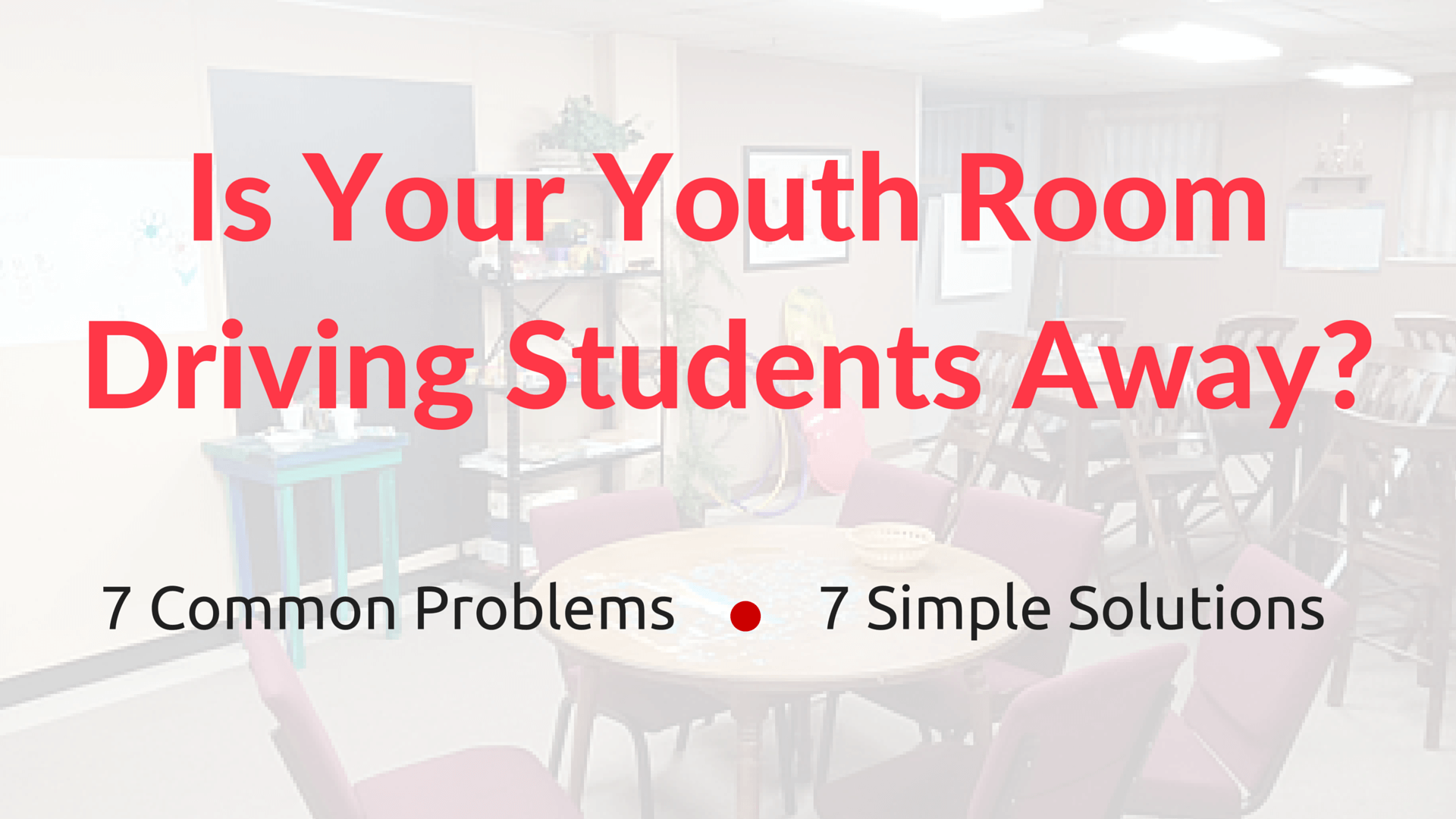I spoke at a high school this morning. It was a student-led Christian group that gathers before school starts.
You’ve probably spoken for groups like this one. And even though the return on investment is debatable, it’s a standard part of being a youth ministry leader.
When I walked into the room (which wasn’t easy to find), I was greeted by a nice student. He was a junior at the school – tall with brown hair, wearing preppy clothes. He told me how the morning would go:
“We will start with announcements. Then a prayer. Elijah will play his keyboard and lead us in 3 songs. Hopefully he’ll get here on time. Then you’ll be up. After you speak, I’ll come back up to dismiss everyone.”
It sounded fine to me. It probably sounds fine to you too, huh? With the exception of a game, it probably sounds about like your typical Wednesday night program.
What I Noticed
As I waited to get started, I began to notice things:
There were random scribbles on the big whiteboard in the front of the room. Chairs were scattered in a disorderly way. On the opposite side of the random scribbles, someone had written the Twitter and Instagram names for the group. Either that person has really bad handwriting or they were in a big hurry because I could barely read it.
Chairs were scattered in a disorderly way. A girl was working quickly at the computer. I asked her what she was up to. She was copying song lyrics from websites and pasting them into a Word document that would be displayed during the singing portion of the morning.
I noticed that it was quiet. Too quiet. And awfully bright. There wasn’t any music playing and every single one of the fluorescent lights that hung on the low-hanging ceiling tiles was turned on.
I wondered where all of the students were. I’d been told there would be around 50 of them here. I was seeing closer to 15. Not only was there a shortage of students, there was also a noticeable lack of food. There weren’t any snacks, not a single breakfast pastry. Nor were there any bottles of water or juice available.
I found the leader of the group again:
“I thought you said there would be around 50 students here.”
He said, “Well, we had that many a while ago, but a lot of them stopped coming.”
“Are you seeing any new people show up?” I asked.
“Not in the last few months,” he said. “I’m not sure why.”
As I looked around, I wasn’t surprised. I knew exactly why. And you can probably guess the reasons.
What’s the Point?
I share this experience because I think that if you switch the setting from a school on a Wednesday morning to your church on a Wednesday night, the situation might sound eerily similar.
Here’s the point:
Your place matters.
In fact, the first step to building a better youth ministry to create a place that is appealing to students. Without an appealing place, students simply won’t show up.
That shouldn’t be controversial, but I get emails and Twitter messages every month accusing me of watering down the gospel with all of this talk about place, and programs, and promotion.
“If kids really love God,” they say, “then they’ll show up.” Or, “Christians in Africa worship in churches that have mud floors and no air conditioning. Our students should be grateful.”
I agree, students should be grateful. Our culture and country allow us to have many luxuries. But I must point out: we’re not in Africa, so it doesn’t help to compare their situation with ours. It’s American students that we’re trying to reach in America, not African students.
“It’s Eighty-Seven Degrees in Here!”
A few summers ago, the air conditioning in our student building stopped working. I asked the church facilities manager to get it fixed. Weeks went by, but it still wasn’t fixed.
I remember a student coming up to me one day saying, “It’s 87 degrees in here!” Was it petty for the students to complain about that? I don’t think so.
Your Place Matters
So let’s all agree that your place (your ministry space, your youth room, whatever you want to call it) matters – and that’s not wrong.
Neither is it new. Even Charles Spurgeon, the great British preacher of the 19th century, said, “Frequently it is very difficult for congregations to attend because of the place and the atmosphere” (Lectures to My Students, 129.
If you want students to enjoy coming to your church, look forward to being there, and feel good about inviting their friends, then you have to pay attention to your place. It was true for Spurgeon in the 19th century, and it’s true for you today in the 21st.
Case Study: Problems & Solutions
So, let’s go back to that high school club and use it as a case study. What is going wrong and how can it be fixed?
Problem #1: The room wasn’t easy to find.
Solution#1: Create a team of greeters. Give them matching shirts with the group name and/or logo on it, and station them at key areas where people could potentially take a wrong turn. Plus, you could get a sign made (nothing fancy, just a simple A-frame sign would be fine) and put it in front of the room so it can be seen down a long hallway of classrooms that all look the same.
Problem #2: No snacks or drinks.
Solution #2: Get a parent to be in charge of finding and scheduling other parents who would be willing to provide refreshments on a weekly rotation. Or you could reach out to a local bakery or bagel shop (Panera does this in my town) and ask them for their day-old items that would otherwise be thrown away. You could even bring a bunch of Chick-fil-A biscuits on the first week of each month and ask students to pay for them. They’ll gladly do it.
Problem #3: Random scribbles on the whiteboard.
Solution #3: Open your eyes and find an eraser.
Problem #4: Illegible social media information.
Solution #4: Either print the info on small, attractive cards to hand out each week, or find an artistic student who has good handwriting to make it look fresh and clean each week.
Problem #5: Disorderly chairs.
Solution #5: Decide if you want rows or a circle, and set up the chairs that way. Make sure that unused chairs are out of the way.
Problem #6: The room is too quiet.
Solution #6: Buy a portable Blue Tooth speaker (the JBL Flip 2 is my favorite) and play some music as people are coming in and hanging out before things get started.
Problem #7: The room is too bright.
Solution #7: Turn on only half of the overhead lights, or go to Walmart and get a few of the cheap, floor lamps – like this one for less than $10.
As you can tell, nothing here is very hard. The things can be implemented very easily, without spending very much money at all. It just takes a willingness to pay attention to make adjustments.
The program itself could be observed, evaluated, and improved in the same way, but the program ran fairly smoothly. I don’t think that’s the reason why students aren’t showing up anymore. I think it has more to do with the environment they’ve created. Their biggest problem is their place. But with some attention to detail that can be fixed.
Your Move
As you read through the list of problems and solutions, did anything stick out to you that might be happening in your place?
Keep your eyes open. Pay attention to what’s going on. See things through the eyes of a guest who isn’t familiar with your room. What if you were walking into that room for the very first time. Would you feel excited? Would you feel awkward? Would you feel comfortable? Would you want to come back?
Let’s chat in the comments. What is the biggest problem that you see right now in your space? Maybe we can come up with a few solutions.
Latest posts by Trevor Hamaker (see all)
- 7 Ways to Deal with Disruptive Students - November 14, 2024
- Fighting Frustration by Shifting Your Focus - November 14, 2024
- What is the Most Important Job of a Small Group Leader? - November 14, 2024
Did You Like This Post?
Sign up to get updates sent to your inbox each week!
You're in! Want more ideas and support for your ministry? Check out the BYM Community!
http://bit.ly/bymcommunity

